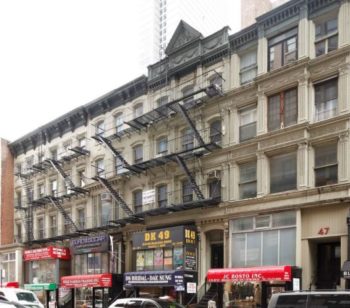
Nos. 47 – 55 West 28th Street were the home of many sheet music publishers in the 1890s and 1900s. Image Credit: NYC LPC
The five buildings were home to popular musicians and publishing firms during the height of Tin Pan Alley. On December 10, 2019, the Landmarks Preservation Commission voted to approve the landmarks designation of five Italianate-style rowhouses located at 47-55 West 28th Street, collectively known as “Tin Pan Alley.” Tin Pan Alley is known for being the home of musicians and sheet music publishers between 1893 and 1910. The area received its nickname from the sounds of pianos played by the publishers on the block. Landmarks held a public hearing for Tin Pan Alley’s designation on April 30, 2019. Many members of the public supported designation; however, the owner of the rowhouses, 45 West 28th LLC, did not. For CityLand’s prior coverage, click here.
At the vote, Sarah Moses, a Landmarks staffer, responded to objections raised at the April 30th public hearing. The first objection was that Tin Pan Alley should not be designated because it is not significant to the City’s musical history. The second objection was that a wider area in Tin Pan Alley should be designated instead of only five rowhouses and the rowhouses have been modified from their original design. The third objection was that racist songs were published at Tin Pan Alley and this history should not be celebrated with a landmarks designation.
Moses stated that Tin Pan Alley is historically significant because it was where musicians and sheet music publishers composed and published the most popular music at the time including iconic songs such as “Take Me Out to the Ballgame.” She stated that at least 73 musicians and publishers, including some from popular firms of the time, worked in the five rowhouses during Tin Pan Alley’s height.
Moses also explained that only the five rowhouses were considered for designation because the buildings are the only ones in the area that have retained most of their historic character from the Tin Pan Alley era. She states that the five rowhouses have undergone little change over time. The only modifications to the rowhouses were conversions to their lower floors to accommodate store fronts and the modifications were done before or during the Tin Pan Alley era.
Moses noted that Tin Pan Alley, like many parts of American history, has a complex past. She states the designation would celebrate the achievements of African-American and Jewish musicians and publishers who were able to have opportunities in the music industry when many opportunities were not available for them and would also acknowledge the racial tension they faced during that time.
Vice Chair Frederick Bland stated that architectural preservation is not celebrating racist history but preservation acknowledges it to avoid masking the truth and people denying the negative history.
Commissioner Michael Goldblum raised concerns about designating only the five buildings. He stated that the buildings are secondary to Tin Pan Alley’s cultural impact and it is actually the space and area that was historic. He explains that if an area, like Tin Pan Alley, is considered as a part of cultural history, a historic district should be designated instead of only five buildings.
Commissioner Michael Devonshire agreed with Commissioner Goldblum but he believes that it is “fantastic” that anything is getting preserved.
Landmarks unanimously voted to approve landmarks designation for the five buildings. Landmarks Chair Sarah Carroll stated that Landmarks seeks to represent the City’s diversity and protect the historic fabric of buildings that contribute to Tin Pan Alley’s history, the City’s music history and culture, and post-Reconstruction era in the City.
In response to Tin Pan Alley’s designation, City Council Speaker Corey Johnson stated that “Tin Pan Alley is the birthplace of American pop music and now we’re ensuring that it will be here for future generations. Like much of American history, the story of Tin Pan Alley is complex and controversial, but preventing its demolition will give future generations the opportunity to learn from it.”
Simeon Bankoff, Historic Districts Council Executive Director, stated that “this long-sought designation is remarkable in strongly demonstrating that sites of cultural significance bring enormous value to our city and are deserving of official protection.”
By: May Vutrapongvatana (May is the CityLaw Fellow and New York Law School Graduate, Class of 2019).

